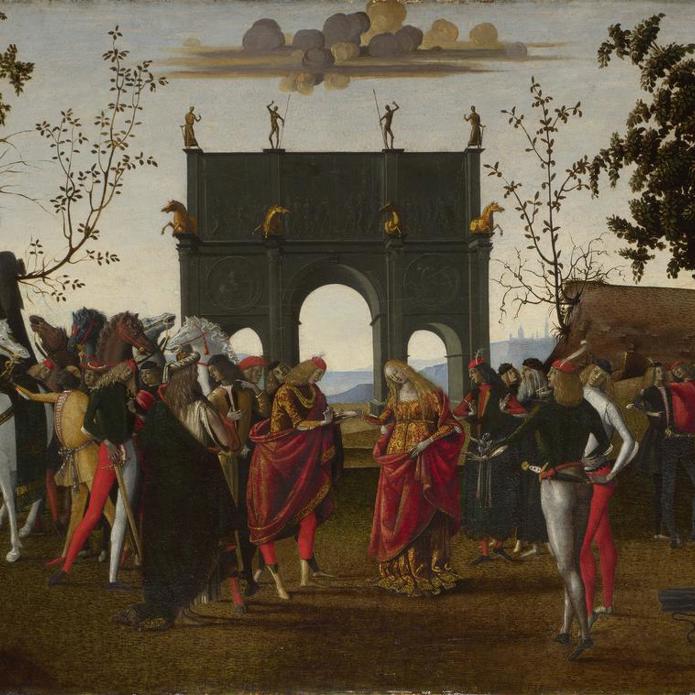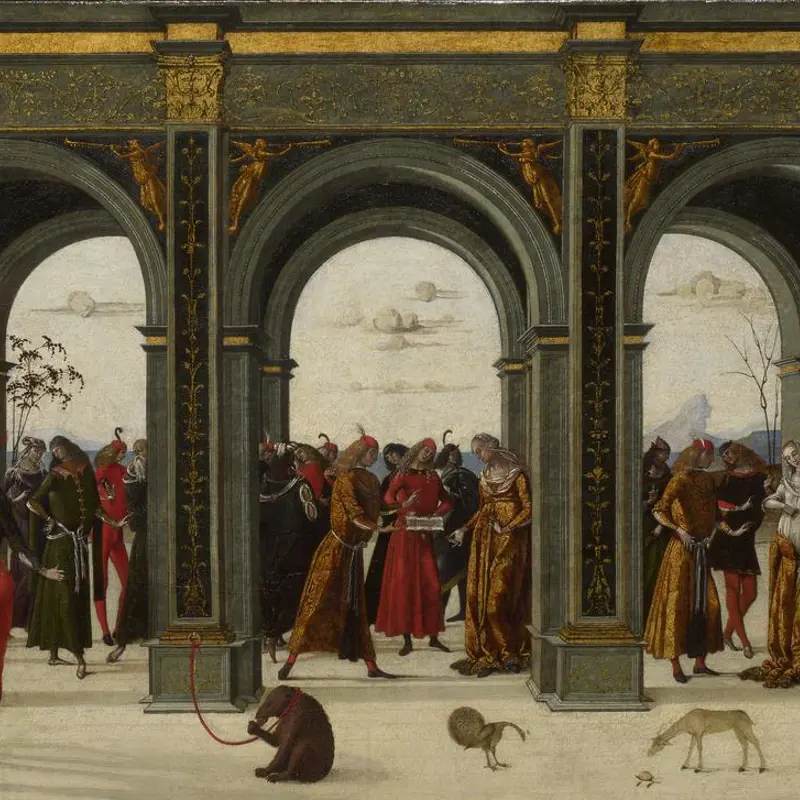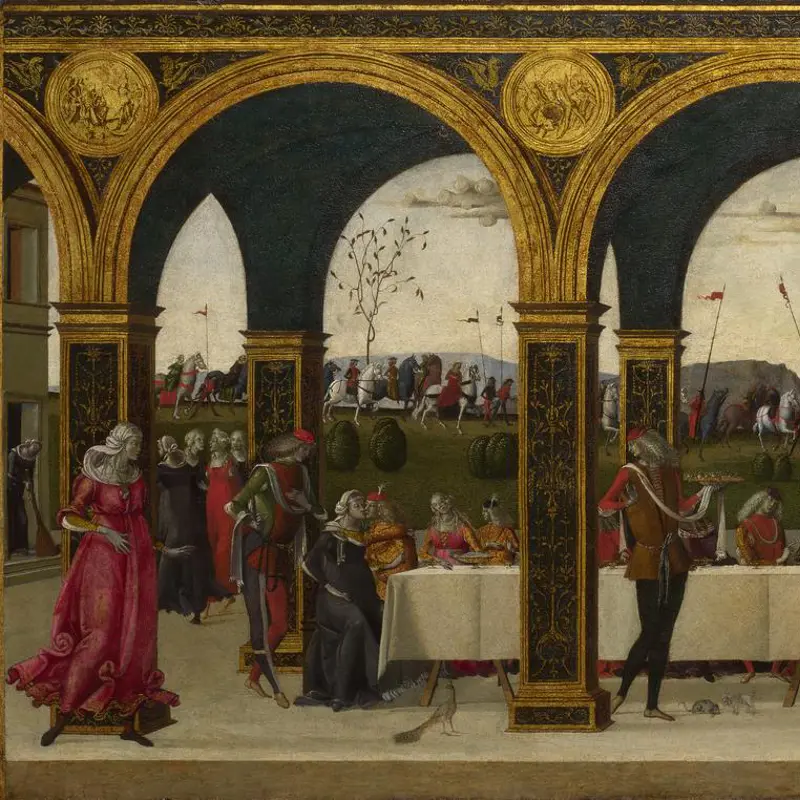Master of the Story of Griselda, 'The Story of Griselda, Part III: Reunion', about 1494
About the work
Overview
The Decameron, a fourteenth-century collection of stories, tells the tale of Griselda, a peasant woman who was put through a series of tests by her rich husband, the Marquis Gualtieri di Saluzzo. This is the final panel of a series of three; it shows the couple’s reunion after Griselda’s ordeal.
After pretending to annul their marriage, the Marquis tells Griselda he is marrying again and asks her to arrange the wedding feast; we see her at the far left of the painting, sweeping the floor. At the far right, Griselda greets the woman posing as the Marquis' new wife. Eventually, the Marquis reveals his tests and is reunited with Griselda; her loyalty has renewed his love for her, and the celebration becomes their own.
The three panels were commissioned for a room in the Spanocchi family palace in Siena, and were probably made to celebrate two family marriages which took place in January 1494.
Key facts
Details
- Full title
- The Story of Griselda, Part III: Reunion
- Artist dates
- Active about 1490 - 1500
- Part of the series
- Spalliera Panels with the Story of Patient Griselda
- Date made
- About 1494
- Medium and support
- Oil with some egg tempera on wood
- Dimensions
- 61.6 × 154.3 cm
- Acquisition credit
- Bought, 1874
- Inventory number
- NG914
- Location
- Room 61
- Collection
- Main Collection
- Previous owners
- Frame
- 20th-century Replica Frame
Provenance
Additional information
Text extracted from the ‘Provenance’ section of the catalogue entry in Martin Davies, ‘National Gallery Catalogues: The Earlier Italian Schools’, London 1986; for further information, see the full catalogue entry.
Bibliography
-
1874Christie, Manson & Woods, Catalogue of the Renowned Collection of Works of Art, Formed by that Distinguished Connoisseur, Alexander Barker, Esq., London, 6 June 1874 - 11 June 1874
-
1900Adolfo Venturi', L'arte, 1900, pp. 235-8
-
1931B. Berenson, 'Quadri senza casa: Il quatrocento senese, II', Dedalo, XI, 1931, pp. 735-67
-
1951Davies, Martin, National Gallery Catalogues: The Earlier Italian Schools, London 1951
-
1961M. Davies, The Earlier Italian Schools, 2nd edn, London 1961
-
1973F. Russell, 'The Evolution of a Sienese Painter: Some Early Madonnas of Pacchiarotto', The Burlington Magazine, CXV/849, 1973, pp. 801-5
-
1979V. Tátrai, 'Il Maestro della storia di Griselda e una famiglia senese di mecenati dimenticata', Acta historiae artium, XXV/1-2, 1979, pp. 27-66
-
1985C. Klapisch-Zuber, 'The Griselda Complex: Dowry and Marriage Gifts in the Quattrocento', in Women, Family and Ritual in Renaissance Italy, Chicago 1985, pp. 213-46
-
1986Davies, Martin, National Gallery Catalogues: The Earlier Italian Schools, revised edn, London 1986
-
1987F. Zeri, La pittura in Italia: Il Quattrocento, Milan 1987
-
1989A. Angelini, 'Intorno al Maestro di Griselda', Annali, II, 1989, pp. 5-15
-
1991J. Dunkerton et al., Giotto to Dürer: Early Renaissance Painting in the National Gallery, New Haven 1991
-
1992F. Zeri, Giorno per giorno nella pittura: Scritti sull'arte dell'Italia centrale e meridionale dal Trecento al primo Cinquecento, Turin 1992
-
1993M. Miller, '"Alcune cose in Siena, non degne di memoria": Baldassare Peruzzi's Beginnings', Allen Memorial Art Museum Bulletin, XLVI, 1993, pp. 3-16
-
1994A.B. Barriault, Spalliera Paintings of Renaissance Tuscany: Fables of Poets for Patrician Homes, Univerisity Park PA 1994
-
1997G.C. Dini, A. Angelini and B. Sani, Pittura senese, Milan 1997
-
1997P. Tinagli, Women in Italian Renaissance Art: Gender, Representation, Identity, Manchester 1997
-
2000R. Jones and P. Stallybrass, Renaissance Clothing and the Materials of Memory, Cambridge 2000
-
2000L. Kanter, 'Rethinking the Griselda Master', Gazette des beaux-arts, CXLII, 2000, pp. 147-56
-
2001
C. Baker and T. Henry, The National Gallery: Complete Illustrated Catalogue, London 2001
-
2005A. Angelini, Pio II e le arti: La riscoperta dell'antico da Federighi a Michelangelo, Siena 2005
-
2005B. Santi and C. Strinatis, Siena and Roma: Raffaello, Caravaggio e i protagonisti di un legame antico, (exh. cat. Santa Maria della Scala, Palazzo Squarcialupi, 25 November 2005 - 5 March 2006), Siena 2005
-
2006National Gallery, The National Gallery Review: April 2005 - March 2006, London 2006
-
2006J. Dunkerton, C. Christensen and L. Syson, 'The Master of the Story of Griselda and Paintings for Sienese Palaces', National Gallery Technical Bulletin, XXVII, 2006, pp. 4-71
-
2007L. Syson et al., Renaissance Siena: Art for a City (exh. cat. The National Gallery, 24 October 2007 - 13 January 2008), London 2007
-
2009D. Norman, 'Exhibition Review: A Triumph of Tradition', Art History, XXXII/3, 2009, pp. 618-29
About this record
If you know more about this work or have spotted an error, please contact us. Please note that exhibition histories are listed from 2009 onwards. Bibliographies may not be complete; more comprehensive information is available in the National Gallery Library.
Images
About the series: Spalliera Panels with the Story of Patient Griselda
Overview
These three long panels illustrate the story of a young peasant woman, Griselda, as told in The Decameron, a fourteenth-century collection of novellas by the Italian author Boccaccio. They were likely destined to decorate the chambers (or camera) of a newly-wed couple, since the tale celebrates a woman’s loyalty and marital fidelity, against the odds.
It is very likely that these panels were commissioned at the time of the marriages of two brothers of the noble Sienese Spannocchi family, which took place in January 1494. Their father, Ambrogio, was the papal banker to Pius II Piccolomini, also from Siena.
Our panels have been connected with two others of a similar shape and size at Longleat House, Wiltshire, which depict ancient leaders Alexander the Great and Julius Caesar. They are attributed to the workshop of the Florentine painters Domenico and Davide Ghirlandaio. The picture of Alexander the Great included the Spanocchi coat of arms.




